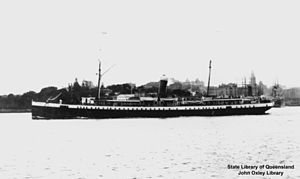 Alameda
| |
| History | |
|---|---|
| Name | Alameda |
| Owner |
|
| Port of registry | New York (by 1930) |
| Builder | William Cramp & Sons, Philadelphia |
| Completed | 1883 |
| Acquired | Never |
| Commissioned | Never |
| Identification |
|
| Fate | Burned down, 28 November 1931 |
| General characteristics | |
| Type | passenger ship |
| Tonnage | |
| Displacement | 5,000 tons |
| Length | 314.0 ft (95.7 m) p/p 332 ft 5 in (101.32 m) o/a |
| Beam | 41.0 ft (12.5 m) |
| Draft | 22 ft 0 in (6.71 m) |
| Depth | 17.3 ft (5.3 m) |
| Installed power | 434 NHP; 3,500 ihp |
| Propulsion |
|
| Speed | 15 knots (28 km/h) |
| Crew | 52 |
| Sensors and processing systems | wireless direction finding |
Note: This ship should not be confused with the motorboat Alameda, considered for World War I service as USS Alameda (SP-1040), but also never acquired or commissioned.
The USS Alameda (ID-1432) was the proposed designation for a steamship that never actually served in the United States Navy.
The Alameda was an iron-hulled passenger liner that was built in 1883 by William Cramp & Sons at Philadelphia [1] for the Oceanic Steamship Company. After the ship was completed in July 1883, eighteen-year-old Maggie Cramp, daughter of Joseph Cramp, played the piano at a reception; while disembarking, she slipped on the gangplank and drowned. [2]
The Alaska Steamship Company bought her in 1910.
After the United States entered World War I in 1917, the U.S. Navy's 13th Naval District inspected her for possible naval service, and she was registered accordingly with the Naval Registry Identification Number (ID. No.) 1432; however, the Navy appears never to have acquired or commissioned her.
The Alameda remained in commercial use until she caught fire at a pier in Seattle on 28 November 1931. She was subsequently scrapped.
See also
- SS Mariposa (1883), sister ship
Gallery
-
S.S. Alameda in service in Alaska, photo taken by John E. Thwaites
References
- ^ Lloyd's Register, Steamships and Motor Ships (PDF). London: Lloyd's Register. 190. Retrieved 16 September 2014.
- ^ "Tragic Eding of a Joyous Occasion". Sacramento Daily Union. 27 July 1883. Retrieved 26 February 2020.
- This article incorporates text from the public domain Dictionary of American Naval Fighting Ships. The entry can be found here.
- NavSource Online: Section Patrol Craft Photo Archive Alameda (ID 1432)
